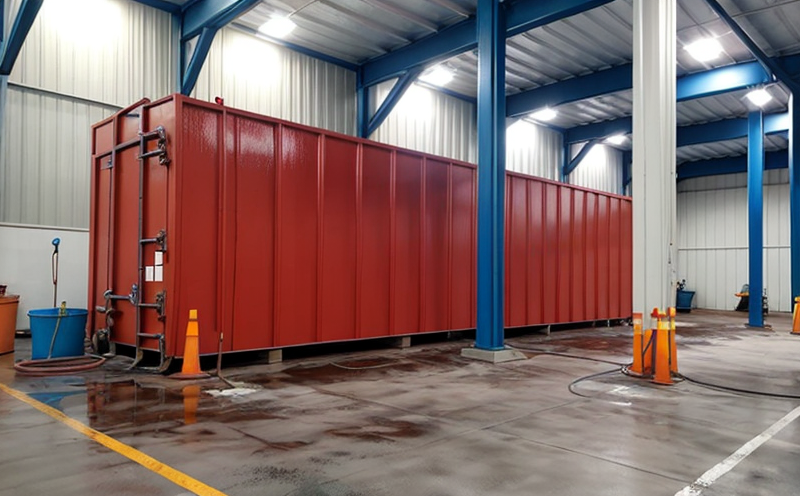DIN 53152 Fogging Resistance Testing of Coated Surfaces
The DIN 53152 fogging resistance test is a standardized method used to evaluate how effectively coatings and paints prevent the formation of condensation or fog on their surfaces. This test is particularly important for industrial settings where moisture exposure is common, such as in humid environments or during temperature changes.
This test is critical for ensuring that coatings provide long-term protection against environmental factors. In industries like automotive manufacturing, aerospace engineering, and construction, the durability of coatings can significantly impact product performance and longevity. The fogging resistance test ensures that the coating not only adheres well to the substrate but also resists moisture-induced damage.
The DIN 53152 standard specifies a procedure where a solution is sprayed onto the surface of the coated sample, and after a defined period, the amount of condensation or fog formed on the surface is visually assessed. The test helps manufacturers understand how well their coatings will perform in real-world conditions.
The importance of this test cannot be overstated for quality managers, compliance officers, and R&D engineers who are responsible for ensuring that products meet stringent quality standards. By using this method, they can identify potential issues early on and make necessary adjustments to improve the performance of their coatings.
For procurement teams, understanding fogging resistance is crucial when selecting suppliers or materials. The DIN 53152 test provides a reliable benchmark for comparing different products in terms of their ability to resist condensation.
| Step | Description |
|---|---|
| Preparation of Specimen | The coated surface to be tested is prepared according to the standard. This includes cleaning, priming if necessary, and ensuring the coating is dry. |
| Solution Application | A specific solution designed for this test is applied to the specimen in a controlled manner to simulate real-world conditions of moisture exposure. |
| Condensation Formation | The specimen is placed in an environment where condensation can form. The temperature and humidity levels are precisely controlled according to the standard. |
| Evaluation | The amount of fog or condensation on the surface is visually assessed using predefined criteria. |
| Parameter | Description |
|---|---|
| Environmental Conditions | The test is conducted under controlled conditions of temperature and humidity to ensure accurate results. |
| Solution Composition | The solution used must be precisely formulated according to the standard to simulate real-world moisture exposure accurately. |
| Evaluation Criteria | Visual assessment is performed using standardized criteria that determine the acceptable limits of fog or condensation. |
Why Choose This Test
The DIN 53152 fogging resistance test is a valuable tool for ensuring that industrial coatings and paints are effective in preventing moisture-induced damage. The test provides clear, quantifiable data on the performance of coatings under specific conditions, which can help manufacturers make informed decisions about their product development.
By choosing this test, quality managers can ensure consistent quality across batches of products, reducing the risk of defects or failures in the field. Compliance officers benefit from the standardized nature of the test, as it aligns with international standards and regulatory requirements. R&D engineers can use the results to refine their formulations and improve product performance.
For procurement teams, this test offers a reliable method for evaluating suppliers' products. By selecting coatings that pass this test, they ensure that their materials meet the highest quality standards, leading to more durable and reliable end products.
The reliability of the DIN 53152 fogging resistance test is further enhanced by its widespread use in various industries. This ensures that the results are consistent across different testing facilities, making it a trusted method for evaluating coatings.
Environmental and Sustainability Contributions
The DIN 53152 fogging resistance test plays a crucial role in promoting sustainability by ensuring that industrial coatings are effective in preventing moisture-induced damage. This contributes to the overall durability of products, reducing waste and the need for replacement.
By using this test, manufacturers can ensure that their products are long-lasting and perform well under various environmental conditions. This reduces the carbon footprint associated with frequent replacements or repairs. Additionally, by selecting coatings that pass this test, procurement teams contribute to a more sustainable supply chain.
The standard also encourages the development of environmentally friendly materials by ensuring that they meet stringent performance criteria. This promotes innovation in the use of eco-friendly chemicals and processes, leading to greener industrial practices.
Furthermore, the results of the DIN 53152 test can be used to improve product design and manufacturing processes, contributing to a more sustainable future. By ensuring that coatings are effective against fogging, manufacturers can reduce energy consumption in heating and cooling systems, as well as minimize water usage in cleaning and maintenance.
The widespread adoption of this standard across various industries further enhances its environmental impact by promoting consistent quality and reliability. This ensures that products meet the highest standards, contributing to a more sustainable industrial sector.





